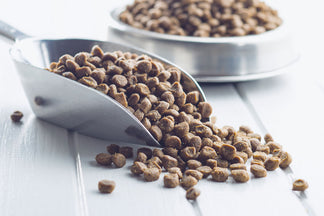Fat, just like protein, is a crucial component to a pet’s diet and provides many health benefits to our pets. However, in addition to the amount of fat in a pet food, the source of fat is just as important. Above and beyond the fat that comes with the protein source, there are many different added fat sources used in pet food -- some of which are more beneficial than others.
The building blocks of fats are fatty acids, some of which pets require in their diet because their body cannot make them. These are called “essential” fatty acids. For example, the omega-3 and the omega-6 fatty acids are essential to both dogs and cats and must be supplied through their diet.
Sources of Fat in Pet Food
The fat in pet food typically comes from the protein source (e.g. the fat content in beef) and the fat sources that are added directly to the food (e.g. chicken fat or, in the form of oil, fish oil). In fact, most pet foods contain some added fat or oils. We did an analysis of over 2,300 dog foods and 1,600 cat foods and found that 73% of dog foods and 65% of cat foods contain added fat. Furthermore, 60% of dog foods and 45% of cat foods contain an oil additive as well.
Like protein, the added fat component of commercial pet food should come from named sources. Below is a list of commonly used higher quality fat sources in pet food. It is easy to recognize the exact source of each of these.
- chicken fat
- beef fat
- lamb fat
- pork fat
- (named) fish oil
- canola oil
- sunflower oil
- safflower oil
Lower quality, questionable fats are mostly of ‘unnamed’ sources including:
- animal fat
- poultry fat
- vegetable oil
- mineral oil
- beef tallow
- lard
That last list looks unappetizing and vague. For example, what exactly is animal fat? The AFFCO defines animal fat as being “obtained from the tissues of mammals and/or poultry in the commercial process of rendering.”
The issue with animal fat is that we really don’t know where it comes from. It could be from by-products (which we have written about in the past), slaughterhouse waste, dead or diseased farm animals, and worse (you don’t want to know). Not very appetizing is it? Enough said.
Something Fishy Going on Here
Fish can provide a rich source of fat (and protein) as well as omega-3 fatty acids. The omega-3’s provide many benefits including:
- Improving the coat and skin.
- Reducing inflammation which can markedly help with arthritis.
- Regulating the immune system.
- Improving cognitive function in older pets.
- Lowering blood pressure.
Of course, if your pet is allergic to fish than you will have to look elsewhere for Omega 3 fatty acids. Unfortunately for cats, their bodies don’t process plant based sources of Omega 3 very well. Consider Krill or mussel oil if your cat has an issue with fish based diets. Flax and other plant based sources will not effectively supply your cat’s body with the Omega 3’s they need.


 Food
Food
 Food
Food
 Food
Food
